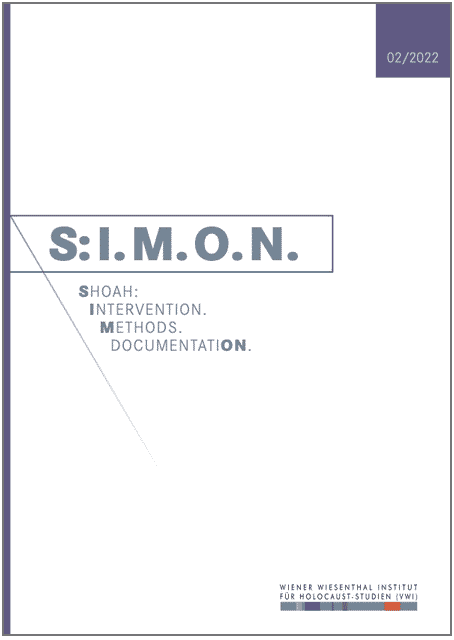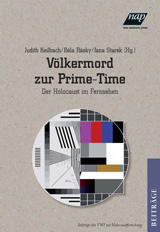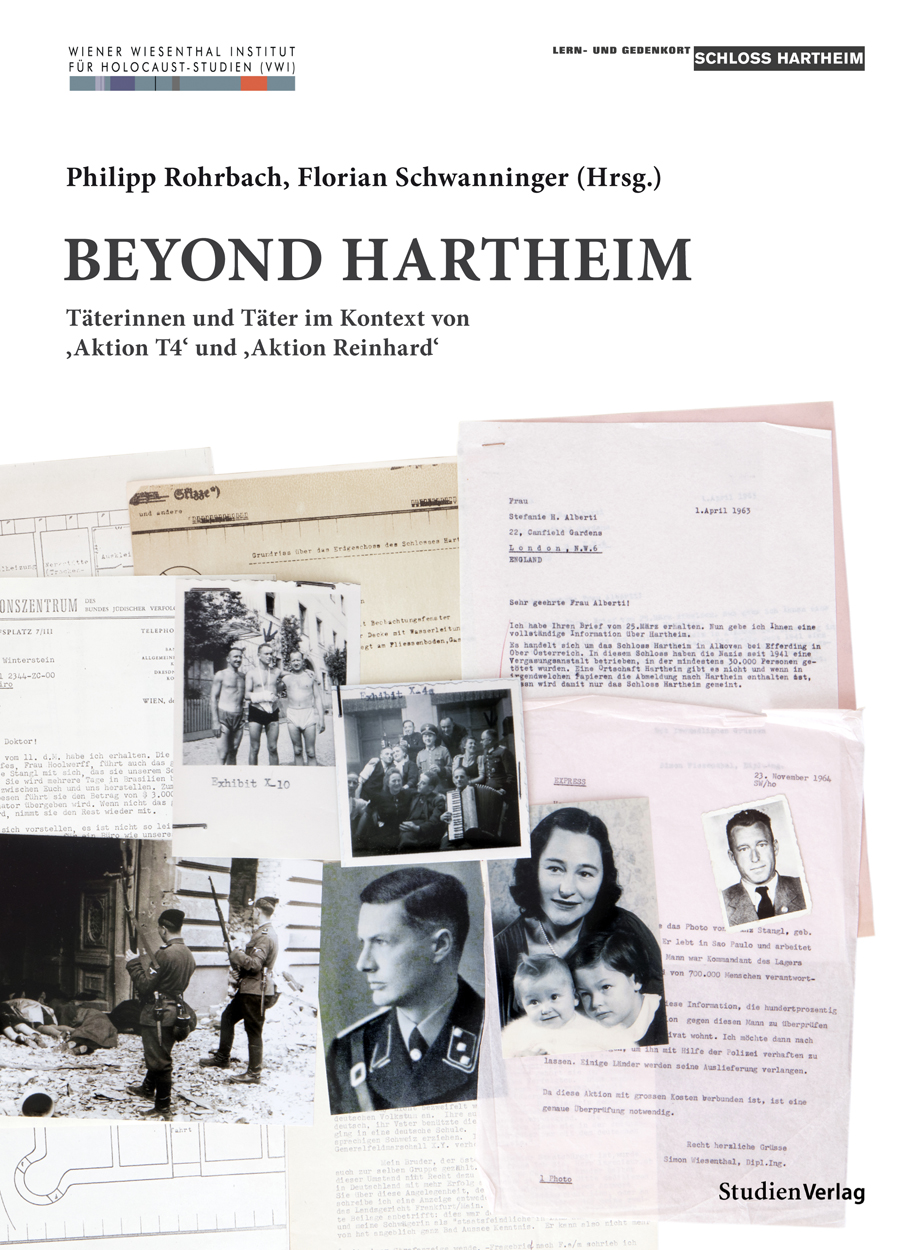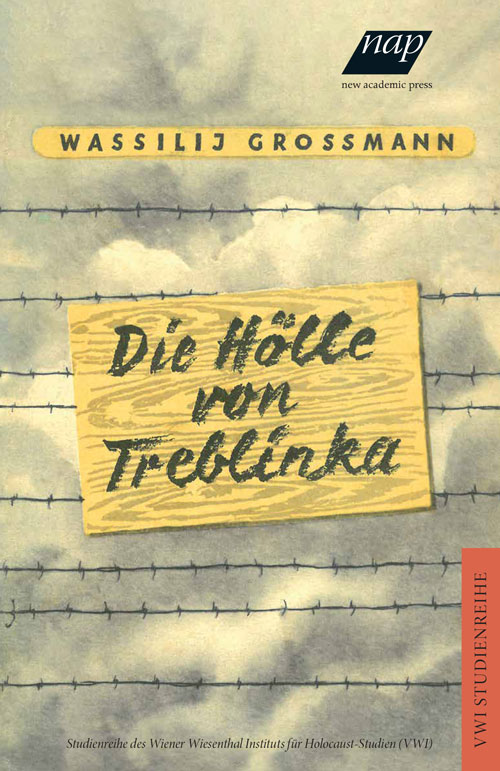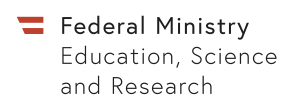News – Events – Calls
| 24. April 2024 19:00 BuchpräsentationIngeborg Bachmann, Marie Luise Kaschnitz, Hilde Domin, Nelly Sachs: Über Grenzen sprechend. Briefe. Piper/Suhrkamp, München, Berlin, Zürich 2023Ingeborg Bachmann stand mit zentralen Protagonistinnen der deutschsprachigen Literatur im Austausch, nun werden ihre Briefwechsel mit Marie Luise Kaschnitz, Hilde Domin und Nelly Sachs erstmals zugänglich gemacht. Die Briefe geben Einblick in die Lebensbedingungen, das literarische S...Weiterlesen... |
| 02. May 2024 18:30 Simon Wiesenthal LectureEdyta Gawron: Never Too Late to Remember, Never Too Late for Justice! Holocaust Research and Commemoration in Contemporary PolandIn 1994, Simon Wiesenthal received a doctorate honoris causa from the Jagiellonian University in Krakow for his lifelong quest for justice – half a century after he had been, for a short time, prisoner of the local Nazi Concentration Camp (KL) Plaszow. The 1990s were the decade when t...Weiterlesen... |
| 07. May 2024 00:00 - 04. June 2024 00:00 WorkshopDealing with Antisemitism in the Past and Present. Scientific Organisations and the State of Research in AustriaThis series of talks, presented by antisemitism experts from different organisations that research antisemitism using a variety of academic approaches, aims to provide a snapshot of historical evolutions, current events, prevalent perceptions and declared (and undeclared) attitudes. I...Weiterlesen... |
| 14. May 2024 08:45 - 16. May 2024 16:30 TagungQuantifying the Holocaust. Classifying, Counting, Modeling: What Contribution to Holocaust History? About the conference: https://quantiholocaust.sciencesconf.org/ Programme timed on the basis of 15-minute presentations + 15-minute discussions; short breaks and lunches Day 1 Tuesday, 14 May 2024Centre Malher (9 rue Malher 75004 Paris/amphi Dupuis) From 8.45 am: Welcome9.30 am...Weiterlesen... |
| 24. May 2024 18:00 InterventionLange Nacht der Forschung 20242024 öffnet das Wiener Wiesenthal Institut für Holocaust-Studien (VWI) in der Langen Nacht der Forschung wieder seine Tore und lädt Interessierte in seine Räumlichkeiten am Rabensteig 3 ein. Im Rahmen von Vorträgen, Podiumsdiskussionen und Präsentationen bieten VWI-Team und Gäste Einb...Weiterlesen... |
“Memories and Imaginaries: Democratic Citizenship”
This citizen science project, funded by the FWF, in cooperation with Univ. Prof. Dr. Marina Gržinić (PI) and her research team (Dr. Jovita Pristovšek and Dr. Sophie Uitz) at the Academy of Fine Arts Vienna investigates the imaginaries of Jewish, queer, and migrant citizen groups in post-Nazi Austria from 1945 until today, specifically imaginaries formed through memories: How are memories by Jewish, queer, and migrant communities manifested within majoritarian narratives of Austrian society? How do members of these communities position themselves in relation to broader hegemonic discourses on state and nationhood? To what extent are democratic counter-discourses performed in these communities? And how do they alter, challenge, or expand the construction of predominant historiographies and citizenship?
“Memories and Imaginaries” is aimed at fostering democratic citizenship and critical thinking at a young age by learning about and exploring the long historical trajectory of discrimination and marginalization (antisemitism, homophobia, racism, and xenophobia) and the almost protean qualities of its inherent structures from an intersectional perspective.
The project follows a novel approach combining citizen science with art-based research offering “Memory Labs” for high-school students during May-June 2022, in which the topic will be explored experientially, for instance, through rap-poetry, performative narration or material-based discussions. Each lab session will be documented in graphic recording by an artist and in shorthand typewriting by a stenograph.
On behalf of VWI, Dr. Mirjam Wilhelm will be involved in these “Memory Labs” as an expert with material originating from her research on ‘forgotten’ Jewish graphic artist Vjera Biller, whose life and artworks serve as an emblematic example of multiple marginalization: as a woman, as a woman artist, as a Jewish woman artist, as a homosexual, and, subsequently, an alleged ‘Geisteskranke’ under Nazi-persecution in Austria.
The project is listed for the OeAD’s Citizen Science Award 2022. Its outcomes will be disseminated via a designated book publication titled Erinnerung und Imaginäres combining the artistic lab-documentation as well as scholarly explorations of the topic.
Prof. Dr. Éva Kovács and Dr. Mirjam Wilhelm are responsible for the project at VWI.
Research Projects at the VWI
The founding concept for the Vienna Wiesenthal Institute for Holocaust Studies (VWI) from the outset envisaged the execution of research projects through third-party funding. This was to ensure that short, mid, and long-term research was conducted independently of the academic work rhythms of the institute. Individually initiated and designed projects, for which funding is sought from national, international, and European funding bodies, play just as much of a central role in this respect as do collaborative research projects that have been conceptualised and brought to the VWI by external project organisers.
Research projects are conducted by a variable number of different staff members who are either employed by the institute or work on the basis of a services contract. Since the establishment of the institute, numerous third-party funded projects have been concluded and several more are currently based at the institute.
The institute constantly endeavours to submit new applications and thereby to explore further research fields and acquire new staff members.
The ‘Invisible’ Austrians
(Self-) Perceptions and Social Positionings of Children of Black American Occupation Soldiers and Austrian Women
The ‘Invisible’ Austrians is a dissertation project that emerged from the research and exhibition project Lost in Administration/SchwarzÖsterreich, which was based at the University of Salzburg from 2013 to 2018 and which was also significantly promoted by the Vienna Wiesenthal Institute for Holocaust Studies (VWI).
Lost in Administration aimed on the basis of narrative biographical interviews to research the life stories of those individuals who were born between 1945 and 1956 to black GIs and Austrian women. Archival research in Austria and the USA was intended reconstruct their treatment by the Austrian and American authorities. Sources and documents that emerged in the context of research on the project have already led to scholarly publications, while thematically relevant materials were moreover made available to the broader public in newspaper articles as well as the exhibition Black Austria. The Children of African-American GIs, which was on display at the Austrian Museum of Folk Life and Folk Art in 2016.
A thorough scholarly appraisal of the interviews and documents is now being undertaken in this dissertation project – which is based at the VWI and the Department of Contemporary History at the University of Vienna – by VWI staff member Philipp Rohrbach.
Most of the children of black American GIs and Austrian women who grew up in ‘white’ post-Nazi Austria had to come to terms with their fate individually, without a peer group. These children thus became a physically visible, but ultimately nonetheless ‘invisible’ population group, remaining for the longest time marginalised not least of all in Austrian historiography. On the basis of a detailed analysis of three narrative biographical interviews that form the core of this dissertation project, the self-perceptions of members of this group will be analysed as they are recounted in their stories. In addition, the dissertation will analyse the largely stereotyped images constructed in these children’s files by child welfare authorities in Upper Austria, Salzburg, and Vienna (the former US occupation zone in Austria). Where relevant for a better understanding of the content emerging from the interviews and documents, the dissertation project will also reconstruct aspects of the (welfare) political treatment of this group after 1945.
The dissertation is being supervised by Prof. Johanna Gehmacher and Prof. Albert Lichtblau and is being conducted in cooperation with the research focus on women’s and gender history of the Faculty of Historical and Cultural Studies at the University of Vienna.
Mapping the Genocide of the Roma in Hungary
Despite efforts by scholars and educators in the last two decades, the genocide of the Roma remains underrepresented in commemorative practices, scholarship, and education on the Second World War in Central Europe. Furthermore, countries like Hungary and Slovakia display strong feelings against their Roma populations. Institutionalised Romaphobia in these countries is in fact reinforcing these negative societal attitudes and obscuring the genocide of the Roma from practices of Holocaust remembrance.
This international partnership will serve to develop an online portal dedicated to the genocide against the Roma in the 1940s, focusing on western Hungary and southern Slovakia, where the deadliest anti-Roma persecutions took place. The key result of the project will be an interactive map visualising the collection and labour camps, sites of killings and atrocities, burial sites, memorials, and routes of forced marches.
This project, which is funded by the International Holocaust Remembrance Alliance (IHRA), will digitise and utilise unexplored archival sources on the topic and offer a complete digital catalogue of archival records from state archives of Hungary and Slovakia with multilingual descriptions to facilitate further research. The portal will moreover incorporate images, thematic maps, glossaries of key persons, places, and subjects, as well as a timeline providing a comprehensive account of the genocide of the Roma in Hungary, including its origins and aftermath, and its contemporary spatial, cultural, and political memory. Complimentary educational materials will be created and integrated, making the portal accessible for educators.
The archive will finally be disseminated to our nationwide network of local authorities, including mayors, civil servants, and directors of school districts, museums, cultural institutions, and NGOs. Local decision makers will thus be able to conduct public lectures, cultural programmes, and educational and commemorative programmes like Roma Holocaust Memorial Day. Ultimately, this project will integrate Roma perspectives in national narratives and educational practices, filling this gap in research, education, and memorialisation.
Responsible for the project, funded by IHRA, is László Csősz (National Archives of Hungary).
Accessing Campscapes
Inclusive Strategies for Using European Conflicted Heritage
In most postwar European countries, former Nazi campscapes have become icons of antifascist resistance and the Holocaust and have thus played a consistent role in postwar European memory of totalitarianism and genocide. In Western Europe, former camps were reused by postcolonial migrants and other refugee groups. In the Eastern European centre of the Holocaust and Stalinist terror by contrast, many former camps remain contested spaces where consecutive internments of prisoners by occupying powers and political regimes transformed the victims of one event into the persecutors of another. This entanglement of remembering with forgetting, along with the silencing of competing narratives, reveals the strong connection between heritage, storytelling, and identity politics, posing a serious challenge to museums, remembrance institutions, civil society organisations, social activists, critical academics, and educators tasked with the development of new and alternative narratives to make such spaces ever more relevant.
The cultural, political, and material dynamics of former camps in Europe were investigated within the framework of iC-ACCESS, drawing on interdisciplinary research perspectives in historical, heritage, and memory studies, forensics, archaeology and material culture studies, and digital humanities – particularly with regard to what has become, in the European context, a dominant set of issues:
- the dynamics affecting the staging and presentation of some Holocaust camps as heritage, and the forgetting of others;
- the recognition and presentation of Stalinist campscapes in Eastern Europe;
- dissonant heritage and competing memories as well as simmering ethnic/regional tensions from the past, exacerbated by the present EU crisis, affecting the identity and future of the European integration project.
iC-ACCESS primarily addressed the role of the campscapes as monuments of the ‘twentieth century of camps’ in an age of transnationalisation, digitisation, and migration.
At the final conference, which took place at the VWI on 13 October 2019, the results of the research carried out between 2016 and 2019 at key campscapes across Europe were presented: Westerbork (The Netherlands), Treblinka (Poland), Falstad (Norway), Jasenovac/Donja Gradina (Croatia/Republika Srpska), Bergen-Belsen (Germany), the former Roma camp at Lety (Czech Republic), former uranium labour camps in the Jáchymov region (Czech Republic), the former Holocaust site at Maly Trostenets (Belarus), and the civil war camp Castuera (Spain).
The conference focussed on the role of testimonies in increasing the accessibility and visibility of such sites for visitors, explored new technologies such as VR/AR and 3- or 4-D-mapping, thereby to connect competing memories in the campscapes, and finally focussed on contested political, narrative, and material dynamics at and around campscapes.
This HERA-JPI project constitutes a collaboration between the University of Amsterdam, the Norwegian University of Science and Technology Trondheim, Staffordshire University, the University of West Bohemia in Plžen, the Free University of Berlin, and the Institute for Bioengineering in Barcelona. It was carried out in collaboration with the following associated partners: Bergen Belsen Memorial, Camp Westerbork Memorial Centre, the Museum of Struggle and Martyrdom in Treblinka, Falstad Memorial and Human Rights Centre, Jasenovac Memorial Museum, Postbellum, the Museum of Roma Culture, and the Vienna Wiesenthal Institute for Holocaust Studies (VWI), and benefitted significantly from the support of companies such as UCL Scanlab, Eodyne Systems, VU Spinlab, and Calibro.
iC-ACCESS has received funding from the European Union’s Horizon 2020 research and innovation programme under grant agreement No 649307.
The Numerus Clausus in Hungary
Antisemitism, Gender, and Exile a Hundred Years On
Act XXV/1920, the so-called numerus clausus law, which was passed by the Hungarian National Assembly in September 1920, has the dubious merit of being the first antisemitic law of the post-First World War era. With the ostensible aim of reducing the overcrowding of Hungarian universities after the Treaty of Trianon, the law pegged enrolment to the ratio of ‘races’ and ‘nationalities’ in the general population. However, the antisemitic agenda of Hungary’s counter-revolutionary regime, the tenor of the corresponding parliamentary debate, and the physical violence inflicted on Jewish students by right-wing student organisations left no doubt about the law’s anti-Jewish intent.
The law’s quota of six percent for Jewish students drastically reduced the previous high representation of Jews at university faculties. It also led to the flight of thousands of Hungarian Jewish students (the so-called NC exiles) to universities abroad, robbing the country of many future leading lights of Western academia. Despite the persistent obfuscations and myths surrounding it, historians agree that the law’s breach of the principle of equal citizenship paved the way for the openly discriminatory anti-Jewish laws enacted in Hungary in the late 1930s and, ultimately, the Hungarian Holocaust.
Women were particularly affected by these state-sanctioned university policies. Hence, gender and politics form the central focus of this project. An early case of illiberal social engineering, the law reflected but also contributed to the deepening divisions in Hungarian society. Our research sets out to gauge its impact on competing perceptions of race, gender, and class, as well as long-term developments of Hungarian society, such as women’s emancipation and Jewish assimilation.
The research will proceed in two complementary directions: First, the law’s impact on Hungarian Jewish women and their decision to venture abroad to study, postpone higher education, or jettison it altogether will be analysed. Daughters of middle-class, assimilated Hungarian Jewish families were at the vanguard of higher education since the partial opening of the faculties in the late 19th century, their ratio in the faculties of arts and medicine reaching strikingly high levels by the end of the First World War. They were thus disproportionally disadvantaged by the NC law, singled out both as women and as Jews by the interwar regime’s deeply conservative agenda and by university administrators who were eager to reverse women’s wartime gains – an endeavour they largely succeeded in. The project will compile data on Jewish women’s enrolment at Hungarian universities, establish their ratio among the NC exiles, and map out the outlines of transnational student networks between 1920 and 1938.
In the second stage that aims to explore the broader social and cultural implications of the NC law, memoirs, oral history sources, and the archives and press of the Hungarian Jewish community will be assessed to answer the following questions: How did the law change the educational strategies of Hungarian Jewish families? Did it slow down Jewish assimilation and reinforce Jewish identity? Of particular interest here is the Hungarian Jewish family, the primary agent of women’s higher education in the pre-First World War period, and its potential to assume, under external pressure, a more conservative gender dynamic.
The project results will be of considerable interest to historians of Hungary and East Central Europe, twentieth-century antisemitism, and intellectual migration from Nazi Europe. The parallels with North American elite universities, where antisemitic measures were widely practised without ever being formalised, also point to the comparative potential of our project.
The project is funded by the Social Sciences and Humanities Research Council of Canada.
Responsible for the project are Judith Szapor (McGill University, Montreal), Éva Kovács (Wiener Wiesenthal Institut für Holocaust-Studien – VWI and Ágnes Kelemen(Central European University.
![]()
Crime Scene Graz-Wetzelsdorf 1945
History – Memory – Commemoration
This project addresses one of the largest Nazi crimes committed on Austrian soil in the end phase of the war in 1945, which has been largely forgotten: the murder of over 250 people in the SS barracks in Graz-Wetzelsdorf, today known as the Belgierkaserne. To this day, this crime has neither been judicially dealt with nor has it been the subject of a systematic scholarly appraisal. Thus, only very little concrete information exists on this event.
In 2010, surviving mass graves were discovered in the barracks. In the context of the memorial year 2020 and the 75th anniversary of the end of the war, this project aims to subject this crime to systematic scholarly analysis, to name the forgotten victims, and to shine a light on the perpetration and especially on the structure of the Waffen-SS association involved, the only one that was stationed in Styria. The project aims ultimately to produce the first ever publication on the ‘Wetzelsdorf case’.
This crime needs to be placed in the context of the death marches of Hungarian Jewish forced labourers, a little explored field which will therefore be augmented decisively by this study. The project moreover entails a memorial culture aspect since the former crime scene is located in the midst of a barracks of the Austrian Armed Forces. In cooperation with this partner, the project will therefore develop forms of commemoration that will ensure a lasting impact for the project.
The project, which is planned to last 14 months and is funded by the Zukunftsfonds and the Nationalfonds, is based at the Vienna Wiesenthal Institute for Holocaust Studies (VWI) and is being conducted by Nicole-Melanie Goll together with Georg Hoffmann.


Diverted to Strasshof
Hungarian Jewish Forced Labourers in Vienna and its Vicinity (1944-1945)
Following the German occupation in 1944, the Hungarian government deported some 440,000 Jews from Hungary between May and July. Most of them were sent to Auschwitz. However, in late June, 15,000 Jews from four Hungarian transit camps (Baja, Debrecen, Szeged, and Szolnok) were not deported to Auschwitz, but to Strasshof an der Nordbahn, a transit camp near Vienna. The deportees mostly comprised Jews who had been living in the many settlements, towns, and small villages of southern Hungary. In the Strasshof camp, a regular ‘slave market’ was opened to meet the demands of Austrian entrepreneurs — both private and municipal — who urgently required labour in their factories and businesses. The deported families had to work in Vienna and in Lower Austria on farms, in commerce, and especially in the war industry.
The main goal of this joint project of the University of Szeged (SZTE) and the Vienna Wiesenthal Institute for Holocaust Studies (VWI), which is funded by the Hungarian National Research, Development, and Innovation Office (NKIF) and the Austrian Science Fund (FWF), is to create a transnational history of Hungarian Jewish forced labour in Vienna and its surroundings. The project aims to further develop the previous research project of the VWI, which was funded by the Foundation Remembrance, Responsibility, and Future (EVZ) and concluded in the spring of 2018, with new, unexplored, and unprocessed documents. In order to understand the entire history of Hungarian Jewish forced labour in Vienna and its surroundings, the archival material of those companies and settlements in which Jewish deportees worked in 1944/1945 also needs to be included. In addition, testimonies of survivors who reported on the events, the deportations, and forced labour in various forms after the Second World War must be identified. To this end, all manner of forums around the world will be identified and incorporated into the project.
Some testimonies - mostly concerning forced labour in Vienna – were already collected during the previous project conducted by the VWI. Yet further intensive archival and museum research is required, including the exploration of private collections, on the circumstances of deportation and forced labour in Vienna and its vicinity, on the conditions of return to Hungary, and on legal steps taken after the war.
Another goal is the expansion of the VWI’s existing bilingual (Hungarian and German) website and database with the Hungarian aspect of the deportation, namely the run-up to the forced relocation to Vienna and its vicinity. The website will also be made available to researchers and laypersons in English. The results will moreover be made available to high schools both in Hungary and Austria as well as for local, regional, national, and international memorial events.
This four-year project is run in Hungary by the Szeged-based historian Judit Molnár and at the VWI by Kinga Frojimovics.
![]()
Research Focus
The VWI International Academic Advisory Board regularly discusses possible future research fields for the institute in its sessions.
In 2012, a sub-commission of the Board named “European Perspectives of Holocaust Research” determined where the VWI ought to focus its research activities in the coming years. The sub-commission consisted of the Board members Gustavo Corni, Susanne Heim, Peter Longerich, and Dieter Pohl. Since 2012, these core fields have made up the basis of academic activities at the institute, ensuring that the VWI will continue evolving into an institution whose import and contribution to academic discourse make it a Central European centre of competence in Holocaust research.
The position paper “Europeanisation of the Holocaust” proposed six subject areas that are to be worked on more closely in coming papers as well as project applications:
- "Anti-Jewish legislation in Europe, 1919/1933 to 1938/41",
- "The murder of the Jews and the European public sphere",
- "Indigenous organisations and the Holocaust outside of the Reich",
- "Administration in the occupied areas, axis regimes and the Holocaust",
- "Reactions by Jewish organisations and communities",
- "Reactions by neutral states and international organisations to the persecution of the Jews in Germany"
All of these topics remain important issues in Holocaust research. However, the concrete implementation of the programme, both for the submissions for fellowships as well as for own project applications or larger tenders for projects of the European Commission in the coming years, further and new topics will become more and more important, such as
- the role of early and local knowledge about the Holocaust,
- genocides/nationalisms in a comparative perspective,
- questions of the ethnicisation of social phenomena,
- questions that the "Jewish Studies" approach pose in the broadest sense,
- the persecution of Sinti and Roma, the integration of other groups of victims of the NS,
- the digital or topographical presentation and visualisation of research results, an expansion of the institute's fields of activity in the direction of „Digital Humanities" and
- forced migration.






